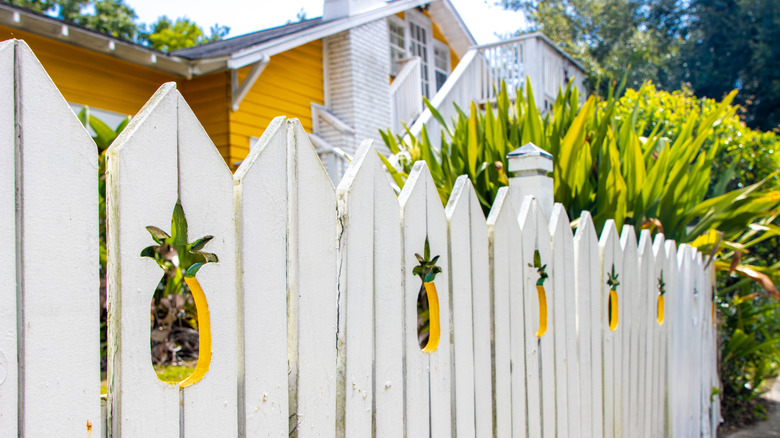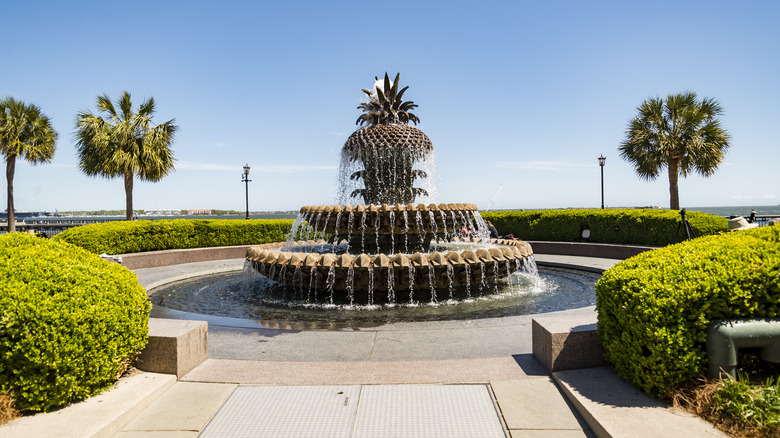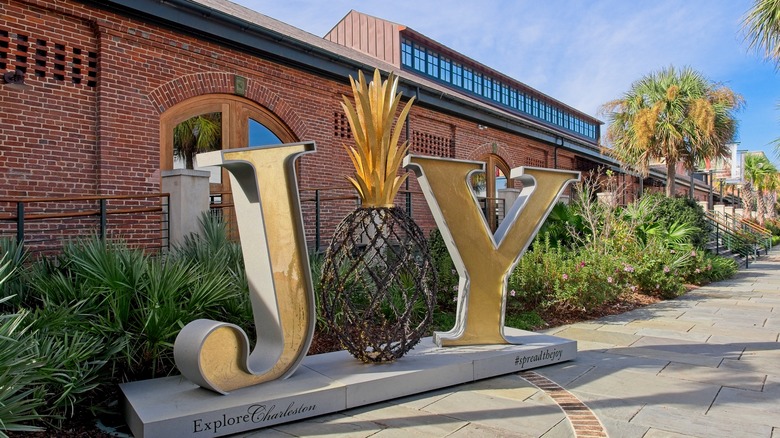What It Means When You See Pineapple Decorations On Homes In The South
If you've ever visited the South, it's not unlikely that you have run into some pineapple decorations somewhere along the line. Most people are not aware of the history and cultural significance behind the pineapple, yet this small fruit has massively influenced Western society as a whole. Today, pineapple decorations in the South have become a well-known and loved symbol of hospitality. However, the tradition and fascination with pineapples did not begin in the South; instead, it started in Europe via tropical Central America and the Caribbean.
It's quite puzzling how this exotic fruit managed to completely infiltrate the world of Western art and architecture, from being embellished onto government buildings, churches, and estates to interior design. Why the pineapple? Why not another tropical fruit like mango or guava? This delicious, highly sought-after fruit has a long, fascinating, and unexpected history. The West's introduction to pineapples all began with the controversial colonial explorer — Christopher Columbus.
How did this tradition begin, and why?
The pineapple is originally Indigenous to the Amazon rainforest and was cultivated and worshipped by the Tupinamba People. When Christopher Columbus set sail on his notorious imperial voyage and encountered a patch of wild pineapple, he was so intrigued and fascinated that he decided to bring this deliciously juicy and novice fruit back to Europe.
Bringing it as a gift to his sponsor, King Ferdinand, pineapple quickly became a highly coveted and expensive status symbol among Europe's elite. It was documented that because pineapples were so scarce and seldomly survived the journey to Europe without rotting, they were sold to Europe's elite at about $8,000 in today's dollars!
Soon after their introduction, pineapples became emblematic of socioeconomic inequality and associated with extravagant wealth. Aristocrats would use pineapples as a centerpiece for lavish banquets, and due to its rare and expensive status, it was regarded as the ultimate sign of hospitality. As a result, the esteemed pineapple became a prominent fixture in European architecture, furniture, and interior design. Pineapples were carved into church doorways, governmental institutions, pillars, or columns on wealthy estates throughout France and England. Additionally, pineapples in design work were always featured in places where the eyes fell since they were associated with wealth, success, and hospitality.
The pineapple's journey to the American South
As wealthy Europeans settled in the American South, the pineapple tradition came with them! According to House Digest's Professional Historian, Nancy Sheppard, the pineapple custom in the South began in Colonial Williamsburg, where the shipping lanes had to survive the treacherous "Graveyard of the Atlantic" to import these in-demand fruits. The long and dangerous journey made them all the more desired and exclusive. Confectionaries in Colonial Williamsburg would even rent pineapples as centerpieces for extravagant banquets and balls. A rare and luxury item, these unique fruits quickly became the ultimate symbol of Southern hospitality.
After the Revolutionary War, pineapples became a sign of rebellion as many planters grew pineapples in hothouses, making them more accessible to the working class. They also became a token of American independence from Britain. Because it was traditionally a highly lusted-after item of success and wealth in Europe, once America became independent and began cultivating domestic pineapples, they became emblematic of independence, self-sufficiency, and freedom.
As pineapples became more accessible, they were no longer associated with a frivolous display of extreme wealth and, instead, were incorporated into Southern Christmas traditions in the 19th century as a friendly gesture of neighborliness and generosity. Today, pineapples continue to be an unwavering symbol of Southern hospitality with a rich and little-known history. The American South isn't the only place with rituals and traditions around the pineapple; In some Chinese homes, a pineapple is used to bring good luck.


